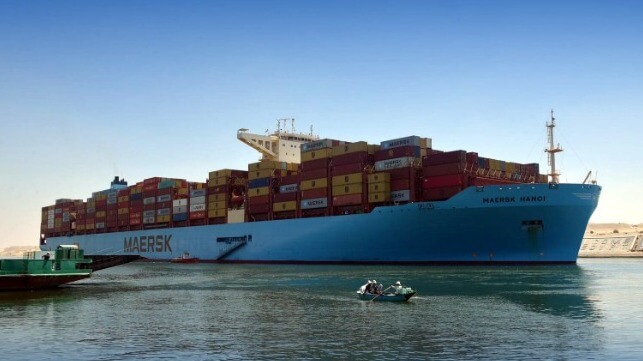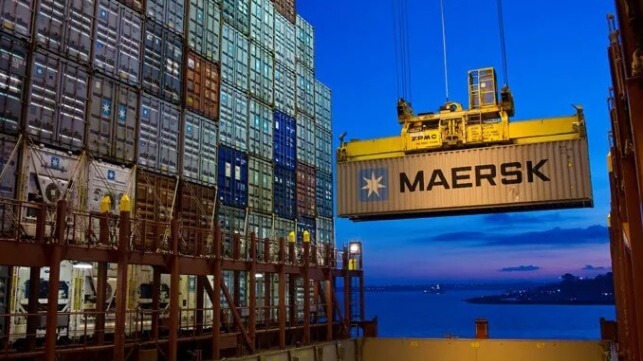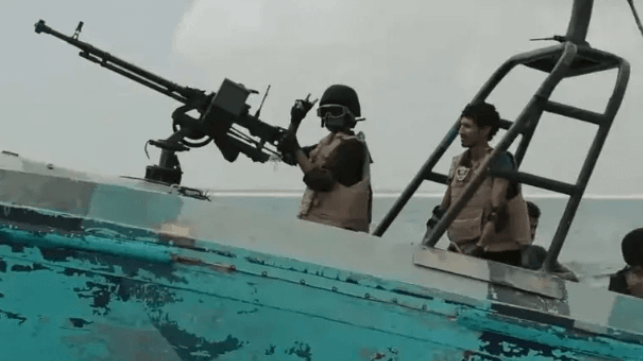Over 120 Boxships Affected by Red Sea Disruption

After a month of attacks by Yemen's Houthi rebels, the number of boxships diverting away from the Red Sea-Suez Canal route is reaching epic proportions, according to freight forwarding insiders. This backbone of east-west trade is suddenly taking a back seat to the traditional route around the Cape of Good Hope, which adds 1,900 nautical miles and 10 days onto a typical Asia-North Europe container service.
According to top forwarder Kuehne+Nagel, there are about 120 container ships totaling 700,000 TEU taking the Cape route as of Wednesday morning. This passage is made regularly by VLCCs and Capesize bulkers, which cannot fit through the Suez Canal, but is almost never used by boxships with their valuable and time-sensitive cargoes. The only other time in recent shipping history when boxships made a mass U-turn towards Africa's southern tip was in 2021, when the boxship Ever Given went aground and fully blocked the Suez Canal for five days.
The disruption will come as welcome relief for container carriers' shareholders. About six percent of all global cellular transport capacity could be affected by the Red Sea disruption, absorbing some of the excess tonnage and significantly boosting freight rates on the westbound Asia-Europe trade lanes. In an otherwise tepid, loss-making market, this high-volume route is now providing a rare prospect of profitability for container carriers.
Share prices for some shipping companies have risen over the past few weeks, including NYK, MOL, and K Line - all up by about 5-6 percent since the start of the disruption. Maersk, which was among the first lines to announce plans to divert away from the Suez Canal, has seen its share price jump by 20 percent in the last two weeks.
Red Sea Repercussions/Uncertainty Add to Container Shipping and Labor Costs

The repercussions continue to mount a week after the major carriers began announcing that they would be rerouting and suspending service through the Red Sea and Bab el-Mandeb Strait after rockets and drones were launched against containerships. Carriers have now begun to announce hefty surcharges that will be added to their shipments to reflect the longer routing and disruption across their fleets while the trade group responsible for the industry’s collective bargaining agreement has decided to implement a high-risk area, raising labor costs for any of the shipping lines still entering the zone.
“The massive spike is already here,” highlights well-known industry analysts Peter Sand of Xeneta, following their forecast that rates could increase 100 percent following Houthis’ missile attacks on merchant ships. Xeneta is reporting that container prices between the Far East and the Mediterranean are up 25 percent per FEU week-over-week.
“Ocean freight carriers are desperately trying to recoup the cost of sending vessels from the Far East to the Mediterranean, North Europe, and U.S. East Coast via the Cape of Good Hope rather than heading through the Suez Canal,” says Sand. The rerouting is expected to length the trips by as much as a third with up to 10 to 14 days added to a typical trip between Asia and Northern Europe which took about 27 days. Then, there are concerns about the fuel supply and bunkering capabilities to handle the onslaught of vessels likely to be rerouting.
Major carriers such as Maersk, CMA CGM, and Hapag-Lloyd all began releasing long lists of rerouted voyages stretching well into 2024. Hapag posted an online listing showing more than 50 trips, while CMA released a list of 22 voyages and Maersk followed with a detailed alert to customers showing an impact on 15 routes. Maersk also released an update saying that it was not accepting any new bookings to/from ports from/to Asia, the Middle East, Oceania, East Africa, Indian Subcontinent, and Indian Ocean islands including the large operations both at Jeddah and the King Abdullah Port in Saudi Arabia.
Maersk also announced late on Thursday that it was imposing a broad schedule of surcharges on its services citing the “severe operational disruption,” as a result of the needed changes. They are implementing both a “Transit Disruption Surcharge” and a peak season surcharge on routes. It can be as high as $700 for each TEU between China and Northern Europe and $500 for services to the east coast of the United States. Maersk is also planning an “Emergency Contingency Surcharge” starting January 1.
Other major carriers are following suit with a range of new surcharges. MSC late on Wednesday rolled out surcharges ranging between $600 and $2,000 per FEU. CMA CGM followed suit on Friday and later Hapag-Lloyd also released its schedule for surcharges.
The rush to implement these surcharges is also triggering concerns among the regulators. Yesterday, the U.S. Federal Maritime Commission (FMC) released a statement saying “The Federal Maritime Commission is monitoring actions taken by ocean common carriers related to rates, fees, and surcharges to ensure their compliance with all statutory and regulatory requirements.” They warned that the charges must meet strict legal requirements, while also saying competition among carriers must not be suspended.
“Sadly, seafarers are often at risk when there is war and global disruptions,” said Toshihito Inoue, who serves as chair of the Joint Negotiating Group, which represents the views of employers across the maritime world. He highlighted the growing concerns among the labor groups and the discussions among the International Bargaining Forum’s Warlike Operations Area Committee.
Effective today, the International Bargaining Forum, which is responsible for the industry’s largest collective bargaining agreement, announced it was officially designating the southern section of the Red Sea and the strait as a High Risk Area. This means that seafarers transiting the area and covered by the IBF agreements are entitled to a bonus equal to their basic wage for the duration of the transit. There are also mandatory requirements to increase security arrangements and the agreement requires double compensation for any seafarer disability or death in the HRA.
“As an employers’ association, it was important for us to reassure seafarers who may be at additional risk in the area that they have appropriate coverage,” said Capt. Belal Ahmed, Chair of the International Maritime Employers' Council and a representative on the Joint Negotiating Committee. “We will also continue to lobby governments to step up their efforts in the region.”
These steps come as the shipping industry continues to wait and watch how the U.S.-led coalition will come together. A Pentagon spokesman highlighted that more than 20 nations have signed on to participate, but the industry is looking for more clarity and action. So far, Air Force Maj. Gen. Pat Ryder addressing the questions at a Pentagon news conference on Thursday said Operation Prosperity Guardian, will serve as the highway patrol in the Red Sea and the Gulf of Aden "to respond to and assist as necessary commercial vessels that are transiting this vital international waterway. It's a defensive coalition meant to reassure global shipping and mariners that the international community is there to help with safe passage."
While rates are already spiking due to the uncertainties and rerouting, Xeneta warns it will not be limited to just the routes directly impacted by spillover into all parts of the system.
“The spike in rates is already here as a result of the Suez Canal diversion, but with Chinese Lunar New Year also on the way and the traditional increases in demand that brings, the cost of ocean freight shipping could grow even more dramatically,” concludes Peter Sand.
Africa’s Maritime Security Experts Weigh In on Red Sea Attacks

For almost a decade, a civil war has dragged on in Yemen, with the rest of the world unperturbed by its progress. However, the ongoing Israel-Hamas war appears to have created a conducive environment for Yemen’s Houthi faction to make a bigger debut on the global stage.
Last month, Houthi rebels started attacking merchant vessels in the Red Sea, claiming that it is a form of retaliation for Israel’s military campaign in Gaza. Since then, missile and drone attacks have been a near-daily event in the area. The impact of the security problem has been substantial, with hundreds of vessels now opting to avoid the Red Sea region and the Suez Canal.
As maritime security expert Dr. Ian Ralby aptly observed in an interview with TME, “The Red Sea security issue is not going to be a quick fix. With the Houthis now enjoying global attention and international navies getting involved, we should expect this to be a long-term problem.”
The question though is whether naval missions - like the recently launched U.S-led Operation Prosperity Guardian - will fully respond to the evolving security threat in the Red Sea. Indeed, Operation Prosperity Guardian is a much-needed response at such a time when merchant shipping requires a security guarantee to transit the Red Sea.
But what constitutes an effective action plan for the current maritime insecurity in the Red Sea?
According to Dr. Ralby, we need to recognize that Houthis have quickly moved from attacking vessels as a show of support for Gaza to more of advancing their own agenda. Ralby added there is a need to divorce the two issues and treat the Houthi attacks as an affront to the global economy, as opposed to taking sides on the ongoing Israel-Gaza war.
To a great advantage, there also exist mechanisms for regional stakeholders in the WIO (Western Indian Ocean) to engage on matters of maritime security. The IMO-led Djibouti Code of Conduct/Jeddah Amendment (DCoC/JA) is such a platform. Established back in 2009, the DCoC and its Jeddah amendment have been able to galvanize support for regional maritime security among its 20 signatory states.
The DCoC/JA jurisdiction spans the WIO and the Middle East, regions which are critical to resolving the current security stalemate in the Red Sea. Early this week, the DCoC Steering Committee convened a special meeting bringing together regional navies and a host of other maritime security stakeholders.
A notable recommendation adopted at the meeting include a proposal to the UN Security Council (UNSC) to pass a resolution on the Red Sea matter, the same way it addressed piracy off the coast of Somalia. At the moment, there appears to be a lack of a uniform approach from all involved nations on how to secure the Red Sea. A UNSC resolution would be helpful to bring all parties on board.
In addition, Africa’s participation is paramount as vessels re-route around the continent. Some areas such as the Horn of Africa and Gulf of Guinea are still affected by maritime insecurity. Kiruja Micheni, Project Manager for the DCoC, reiterated this point in an interview with TME, saying that DCoC is on standby to provide a collaborative platform for regional states in WIO. Under the DCoC framework, regional and international players have an opportunity to rally together to safeguard safety and security of navigation in the Red Sea.
With DCoC involved in suppression of the Somali piracy, Kiruja pointed out some lessons that could be valuable for stakeholders in the Red Sea. The most important one is establishing unity of purpose among nations, which provided coherence of approach in dealing with the Somali pirate threat.
Another important lesson is on information sharing, an area of expertise regional states in WIO have been able to develop through the Regional Maritime Information Fusion Centre in Madagascar (RMIFC)and the Regional Centre for Operational Coordination in Seychelles (RCOC). These centers were established under the Maritime Security (MASE) program by the Indian Ocean Commission (IOC), primarily to bolster maritime domain awareness among nations in the region.
“To be frank, we do not expect RMIFC and RCOC to play a leading role in resolving the Red Sea maritime insecurity. However, the two centers could work with the major international naval forces already deployed in the region. In concrete terms, there could be regular exchange of information between these organizations, monitor the situation, analyze the possible impact to the region and if need be, mobilize action from experts,” said Raj Mohabeer, Head of Maritime Security at IOC.
The opinions expressed herein are the author's and not necessarily those of The Maritime Executive.
No comments:
Post a Comment